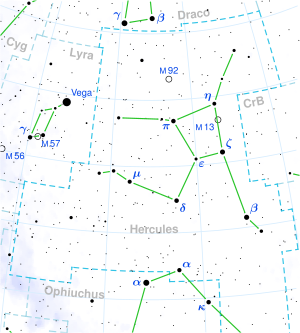| Observation data Epoch J2000 Equinox J2000 | |
|---|---|
| Constellation | Hercules |
| Right ascension | 16h 24m 09.314s [1] |
| Declination | +48° 21′ 11.11″ [1] |
| Characteristics | |
| Spectral type | M3.0V [2] |
| Astrometry | |
| Radial velocity (Rv) | −28.06±0.59 [1] km/s |
| Proper motion (μ) | RA: 1,145.2 mas/yr [3] Dec.: −450.7 mas/yr [3] |
| Parallax (π) | 125.0±0.3 mas [3] |
| Distance | 26.09 ± 0.06 ly (8.00 ± 0.02 pc) |
| Orbit [3] | |
| Period (P) | 1,367.4±0.6 d |
| Semi-major axis (a) | 1.894±0.019 AU [4] |
| Eccentricity (e) | 0.629±0.004 |
| Inclination (i) | 152.5±0.2° |
| Longitude of the node (Ω) | 98.3±0.5° |
| Periastron epoch (T) | 45838.7±2.8 |
| Argument of periastron (ω) (secondary) | 245.4±0.5° |
| Argument of periastron (ω) (primary) | 65.4±0.5° |
| Details | |
| A | |
| Mass | 0.379±0.007 [3] M☉ |
| Radius | 0.404 ± 0.024 [5] [a] R☉ |
| Luminosity | 0.0196+0.0024 −0.0021 [5] L☉ |
| Temperature | 3,400±25 [5] K |
| B | |
| Mass | 0.114±0.002 [3] M☉ |
| Radius | 0.133 ± 0.008 [5] [b] R☉ |
| Luminosity | 0.00103+0.00013 −0.00011 [5] L☉ |
| Temperature | 2,840±27 [5] K |
| Other designations | |
| GJ 623, HIP 80346, G 202-45, LHS 417 [2] | |
| Database references | |
| SIMBAD | data |
Location of Gliese 623 in the constellation Hercules | |
Gliese 623 is a dim binary star 26.09 light-years from Earth in the constellation Hercules. It was photographed by the NASA/ESA Hubble Space Telescope's Faint Object Camera in 1994. [6] The binary system consists of two red dwarfs orbiting each other at a distance of 1.9 astronomical units. [4]



